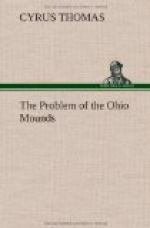The next argument is founded on the fact that in the ancient works of the region alluded to are discovered evidences of habits and customs similar to those of the Cherokees and some of the immediately surrounding tribes.
In the article heretofore referred to allusion is made to the evidence found in the mound opened by Professor Carr of its once having supported a building similar to the council-house observed by Bartram on a mound at the old Cherokee town Cowe. Both were built on mounds, both were circular, both were built on posts set in the ground at equal distances from each other, and each had a central pillar. As tending to confirm this statement of Bartram’s, the following passage may be quoted, where, speaking of Colonel Christian’s march against the Cherokee towns in 1770, Ramsey [Footnote: Annals of Tennessee, p. 169.] says that this officer found in the center of each town “a circular tower rudely built and covered with dirt, 30 feet in diameter, and about 20 feet high. This tower was used as a council-house, and as a place for celebrating the green-corn dance and other national ceremonials.” In another mound the remains of posts apparently marking the site of a building were found. Mr. M. C. Read, of Hudson, Ohio, discovered similar evidences in a mound near Chattanooga, [Footnote: Smithsonian Rept, for 1867 (1868), p. 401.] and Mr. Gerard Fowke has quite recently found the same thing in a mound at Waverly. Ohio.
The shell ornaments to which allusion has been made, although occasionally bearing designs which are undoubtedly of the Mexican or Central American type, nevertheless furnish very strong evidence that the mounds of east Tennessee and western North Carolina were built by the Cherokees.
Lawson, who traveled through North Carolina in 1700, says [Footnote: Hist. of N. C., Raleigh, reprint 1860, p. 315.] “they [the Indians] oftentimes make of this shell [a certain large sea shell] a sort of gorge, which they wear about their neck in a string so it hangs on their collar, whereon sometimes is engraven a cross or some odd sort of figure which comes next in their fancy.”
According to Adair, the southern Indian priest wore upon his breast “an ornament made of a white conch-shell, with two holes bored in the middle of it, through which he ran the ends of an otter-skin strap, and fastened to the extremity of each, a buck-horn white button.” [Footnote: Hist. Am. Indians, p. 84]
Beverly, speaking of the Indians of Virginia, says: “Of this shell they also make round tablets of about 4 inches in diameter, which they polish as smooth as the other, and sometimes they etch or grave thereon circles, stars, a half-moon, or any other figure suitable to their fancy.” [Footnote: Hist. Virginia, London, 1705, p. 58]
[Illustration with caption: Fig. 2. Engraved shell gorget from a Tennessee mound.]




